Mark L. Van Name's Blog, page 172
May 5, 2013
Sabbatical FAQs: How I traveled
As I mentioned in the previous blog entry, while I was in Europe, a lot of folks asked me a lot of questions. I’m answering the most common ones in a set of three blog entries, of which this is the second. And, it's a bonus day: two entries for a May Sunday!
How was it traveling alone?
I’d mentioned to quite a few folks that I was expecting to travel alone. I’d also offered to a group of friends that if they could live with my rules and trip structure, and if they had the time off and the resources to do the trip, they were welcome to join me. Jennie did, and we toured together for the whole trip. Gina joined for most of Amsterdam.
How were they so lucky?
They agreed to the rules and structure, and they had the time and resources to do so.
What were these rules and structure?
Basically, that I was going to do whatever I felt like doing, and I was going to do it in luxury. I planned absolutely as little as possible, so I woke up each day with somewhere between no idea what I was going to do and a simple idea, e.g., go see the Louvre some more. Anyone with me could, of course, make a plan and follow it, but anyone who wanted to stick with me had to live a largely unplanned life.
Why did you almost always write as “I”?
Because this blog is mine and reflects only my opinions. I didn’t want to have to represent a consensus or even differing opinions; I wanted to give my reflections on what I’d experienced.
What made it a luxury trip?
Basically, the hotels I chose and the fact that when I went by train, I rode in first class and, whenever possible, on high-speed trains.
How’d you get from city to city?
From Raleigh to Paris at the beginning, and from Paris to Raleigh at the end, via American Airlines.
From Paris to Florence, the train ride would have taken over 12 hours, so I flew on Air Italia.
From Florence to Venice, via high-speed train.
From Venice to Vienna, again the train ride would have taken over 12 hours, so I flew on Austrian Airways, operated by Air Moldavia.
From Vienna to Prague, by train.
From Prague to Amsterdam, once again the train ride would have taken over 12 hours, so I flew on Czech Air.
From Amsterdam to Paris, by high-speed train.
What were these luxury hotels?
Both Paris stays: The Mandarin Oriental Paris.
Florence: The first was the Relais SantaCroce, and then when it was booked and I wanted to stay longer, the HotelBrunelleschi.
Venice: The Westin Europa & Regina Venice. (I’d intended to stay at a hotel owned locally, but after checking into three rooms, all with terrible Wi-Fi and all tatty, I left it and went to the Westin, which was marvelous.)
Vienna: The Ritz-Carlton Vienna.
Prague: The Mandarin Oriental Prague.
Amsterdam: The Sofitel Legend The Grand.
I may rate the hotels on different criteria in a later blog entry.
Why didn’t you name the hotels earlier?
I liked the feeling of people not knowing where I was, and if someone was looking to track me down (e.g., for work), I wanted to restrict them to email or phone. I didn’t want to be able to receive any packages or surprise visitors.
You’ve mentioned before traveling in Europe on the cheap, and now you’ve traveled in luxury. Which do you prefer?
Luxury. No doubt. I’ve loved all my European vacations, but staying in great hotels makes everything easier and more comfortable, and I intended to spoil myself this trip.
Was it worth what you paid for it?
From a “look at how much good you could have done with that money” perspective, certainly not. For me, for this trip, which very well might end up being the European trip of a lifetime for me, absolutely. And, I’d saved up for years for it, so I haven’t hurt my financial situation by doing it.
How much did you spend?
I’m always amazed that people will ask this, but they do. I’m not going to answer this question, because I don’t think it’s anyone else’s business.
Published on May 05, 2013 10:00
Sabbatical FAQs: Health and physical stuff
In the course of the six weeks I was touring around Europe, a lot of folks asked me a lot of questions. I answered some in email and filed away others for later. I’m going to use this and a couple of other blog entries to try to answer the most common ones. I’ll start with the many questions about my health and appearance.
What’s up with the short hair in that kitchen photo?
Before I went to work at the Shepherd’s Table Soup Kitchen, I asked Gina to cut my hair shorter than I’ve worn it since middle school, so that as it grew out during the trip I would not turn excessively shaggy. As it turns out, I liked the really short cut, so I might ask her to repeat it. Or not. I don’t think a lot about my hair.
In that one photo, you look like you’ve lost weight. Have you?
I wouldn’t rely on any of the scales in any of the hotel rooms, so I can’t be sure, but I believe I’ve lost a little. I think this because I’m now wearing my belt two notches tighter, and the notches are about an inch apart. So, the odds are good that I’m down at least somewhat.
What diet did you use to lose the weight?
I didn’t follow any strict diet. I tried not to eat when I wasn’t hungry, and I tried to keep most meals simple. Most days, lunch would be a simple sandwich, and dinner would be a bowl of pasta and, if I could get it, a salad.
That said, I ate desserts most days, though on many of them the dessert was the smallest cup of gelato on offer.
I also ate quite a few large multi-course meals, though probably no more than one a week.
I also walked as much as possible. I have no clue how far I walked each day, though I joked often about trying to make sure I walked “a mile” each day. I didn’t walk fast, but I avoided taxis whenever reasonably possible and just put feet to (uneven) pavement.
In a show I saw at the Carolina Theater, Henry Rollins described the basics of dieting as requiring only seven words:
Eat less.Eat better.Move your body.
I vaguely and unintentionally, but not religiously, followed Rollins’ advice.
Are you healthy now?
No. Far from it. I’m healthier, in that I am at least somewhat lighter and I can now walk all day without feeling it; on the first day in Paris, a long walk left me sore and exhausted. I’ve also slept a ton (though not on my last night in Paris), and so I feel better both physically and mentally.
I am far from healthy, however, because I’m entirely too heavy and in nowhere near the physical condition I should be. Getting into shape will be a major focus area for me for the next couple of years, which is how long I estimate it will take me to get into even half-decent shape.
What’s your plan for getting in shape?
Right now, I have resolve but not a lot of plan. I’ve also learned that the plans I talk about tend to be ones that I don’t succeed at, so I’m going to stay mum on this topic for a while. If I can implement something that works, and if I can stick with it for a while, I may discuss it later.
So, stay tuned.
Published on May 05, 2013 08:45
May 4, 2013
Back at the Louvre
As I mentioned in Friday’s post, after touring many of the great art collections of Europe, I have to give the Louvre the nod as the largest and overall most impressive collection I’ve seen. Others sometimes speak more to my heart, but the Louvre is simply overwhelming.
On the walk to it, I took a different path than usual and strolled by this lovely church, whose name I never caught.
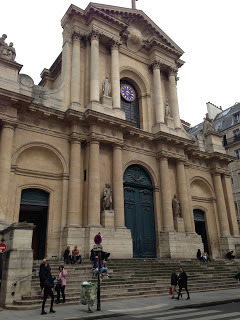 Click on any image to see a larger version.
Click on any image to see a larger version.On the lawn across the street from the pyramid, people enjoyed the day that was, despite being completely overcast, balmy and lovely.
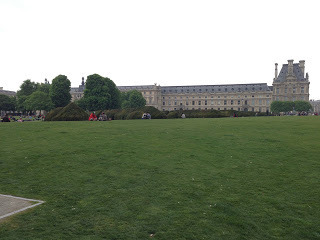
The first sight of Winged Victory of Samothrace always touches me.
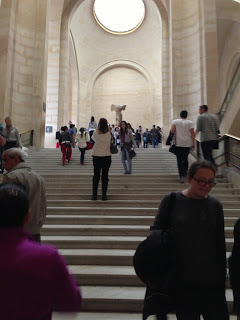
Up close, despite the missing bits and the restoration, she is truly magnificent, lovely from every angle and, for me, more moving than most sculpture.

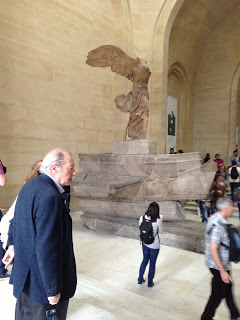 What remains of her right hand sits in a nearby case, an oddly touching fragment reaching forever for nothing.
What remains of her right hand sits in a nearby case, an oddly touching fragment reaching forever for nothing.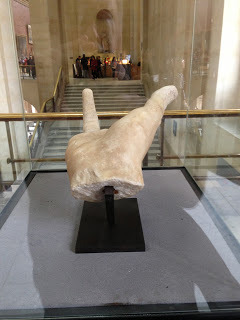
If you’ve read my Florence entries, you know how much I love certain Italian painters. One of my favorites is Botticelli. I don’t recall seeing frescoes from him, but I in the Louvre I was lucky enough to get to study two of them. Both are clearly incompletely but nonetheless beautiful.
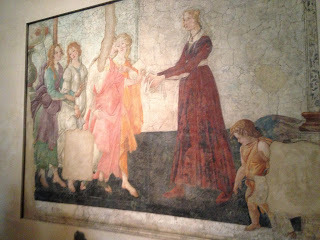
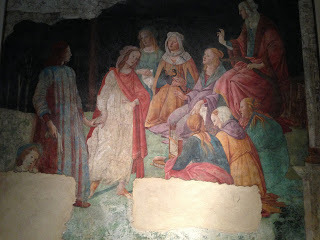 The Louvre will take on anyone in any area. You want a ceiling fight? The Louvre is ready.
The Louvre will take on anyone in any area. You want a ceiling fight? The Louvre is ready.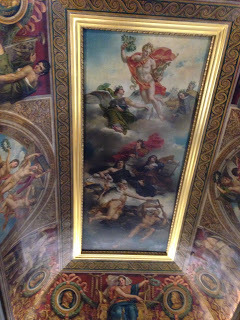
Gorgeous work by Lippi was readily available.
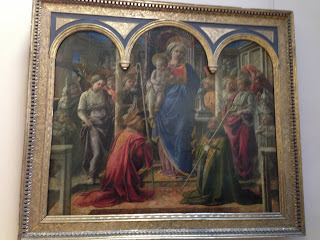 Want some more Botticelli? Take three.
Want some more Botticelli? Take three. 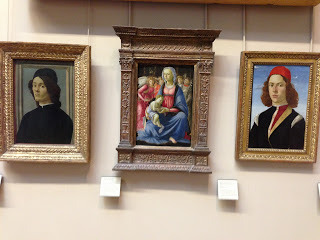
Okay, make it four.
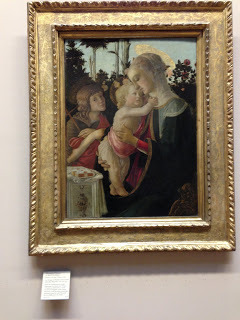
By the way, the Louvre permits non-flash photography, so I wasn’t breaking any rules this time.
One side of one floor of one of the four major wings is the Grand Gallery. I took this shot from one end to give you a sense of the scale of just this one gallery.
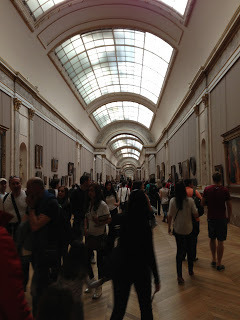
As near as I could tell, they don’t know who painted this one, but it interested me.
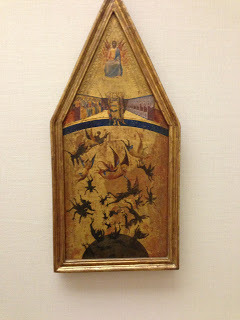 How Bartolomeo got away with painting this odd tableau I do not know, but I very much liked it.
How Bartolomeo got away with painting this odd tableau I do not know, but I very much liked it.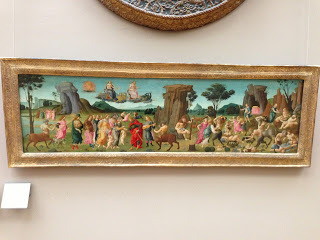
Veronese was definitely in the house!
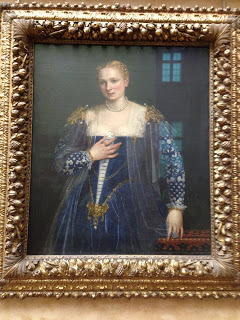 If I hadn’t seen his largest painting—and the world’s largest oil painting—in Venice, this would have been the biggest Veronese work I’d ever seen.
If I hadn’t seen his largest painting—and the world’s largest oil painting—in Venice, this would have been the biggest Veronese work I’d ever seen.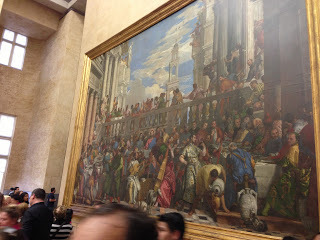
I know next to nothing about Paris Bordone, but after seeing this beautiful portrait, I want to see more of his work.
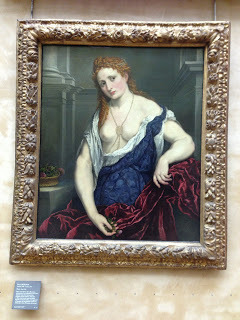 Titian had a presence.
Titian had a presence.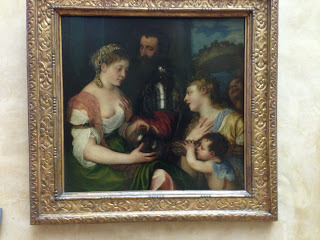
As did the amazing Raphael.
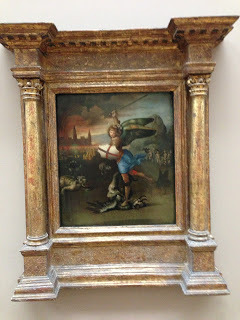 Andrea di Bartolo filled a few walls. I quite liked this one.
Andrea di Bartolo filled a few walls. I quite liked this one.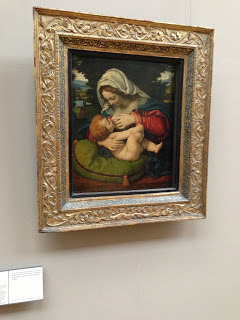 And then there were the Da Vinci paintings. Yes, I again saw the Mona Lisa, though only through a giant scrum of people kept at bay by a wood partition, four guards, and two layers of glass. Yes, the Mona Lisa is all you’ve heard and more. So, though, are the other works of his on display.
And then there were the Da Vinci paintings. Yes, I again saw the Mona Lisa, though only through a giant scrum of people kept at bay by a wood partition, four guards, and two layers of glass. Yes, the Mona Lisa is all you’ve heard and more. So, though, are the other works of his on display. 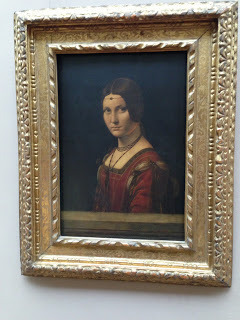
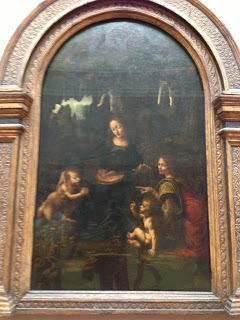
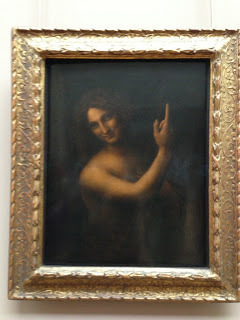
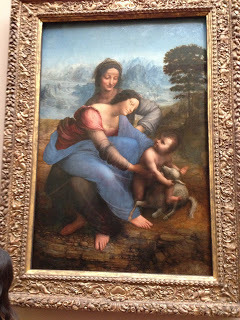
Any time you start to think you’re smart and feel like you might be getting too big for your britches, no matter you are, think about Da Vinci, and get humble. I sure do.
My new buddy, Arcimboldo (go back to the Vienna entries to see more of his work), had two pieces here, including this entry in his Seasons series, Autumn.
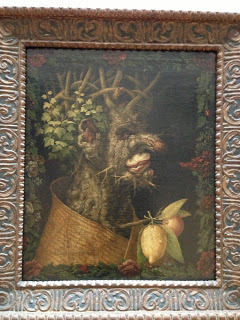
As big as many of the paintings in the Grand Gallery were, the Louvre has a whole section of a wing dedicated to “large-format” paintings. Among them was this wonderful Delacroix.
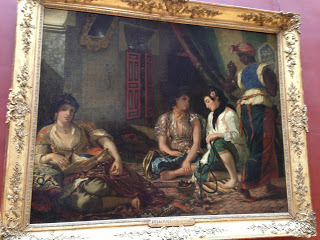
Ingres’ Odalisque deserves all the praise it’s received, more lovely in person than in any book.
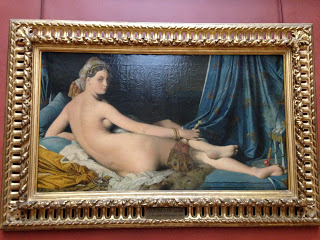 I like David’s work, but a lot of it feels static and posed. For no good reason, this one did not strike me that way, and I very much liked it.
I like David’s work, but a lot of it feels static and posed. For no good reason, this one did not strike me that way, and I very much liked it. 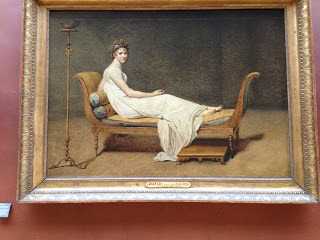 Hours after entering it, I left the Louvre, my brain and heart full from so much great art. After two long visits to it, I hadn’t seen even a quarter of it. Another reason to go back to Paris!
Hours after entering it, I left the Louvre, my brain and heart full from so much great art. After two long visits to it, I hadn’t seen even a quarter of it. Another reason to go back to Paris!I wish I were wealthy enough to be able to take all my friends to the Louvre and these other great galleries. Seeing the art in person is a completely different experience from studying it in a book.
Outside, a gorgeous spring garden provided a great way for me to re-enter the world.
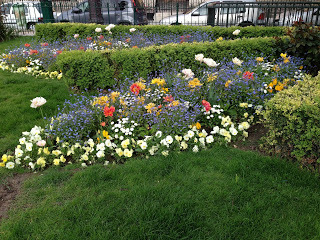
The back of Notre Dame in the fading light of a gray day.
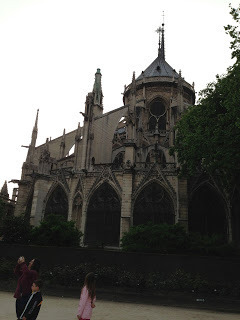
The day ending, on the bridge to Notre Dame from Ile Saint-Louis, a strange man chanted and invoked odd magicks in the service of odd art from recycled materials—and in the hopes of gathering a few coins from passersby.
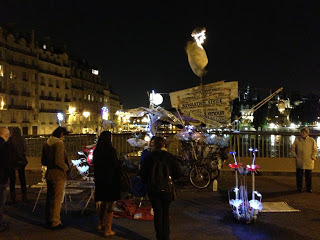 Ah, Paris, I will miss you!
Ah, Paris, I will miss you!Now, I’m in Miami International Airport waiting for the flight to RDU. It’s also good to be back in the U.S.
Published on May 04, 2013 13:11
May 3, 2013
The Louvre: The ultimate art home-court advantage
It is. It just is. I'll tell you more about my long second (of this trip) visit to the Louvre, but not now; that will have to wait until tomorrow. I have to get up quite early in the morning to start the long process of traveling home, and I have yet to pack. Plus, I haven't gotten up early in six weeks! (Yeah, I know: you have no sympathy.)
More tomorrow.
Published on May 03, 2013 20:59
May 2, 2013
Paris perfection
Paris delivered a perfect day today. High sixties, a light breeze, and perfectly clear skies made walking outside a treat. Remember that fountain I showed in
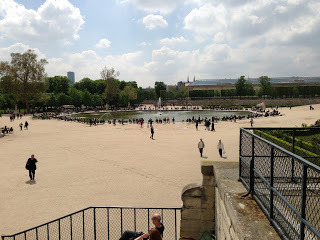 Click on any image to see a larger version.
Click on any image to see a larger version.Not far from this fountain stands the Musee de l'Orangerie, a museum I've repeatedly meant to visit but had not yet managed to tour. Today, I did.
If you're not familiar with the Orangerie, its main focus is a set of eight paintings of water lillies, the Nympheas, that Claude Monet created specifically to go there. He painted these huge canvases after the government agreed to display them in two specially designed oval rooms in the museum. He finished them in about a year, just a few years before he died, but he wouldn't give them up until his death. I've seen a lot of Monet, and I quite like his work, so I was pleased to get the chance to see these paintings.
I was not prepared, however, for how brilliant and moving they are. Books simply cannot do them justice. I broke the no-photo rule once with this picture, just to give you some sense of the scope of these canvases.
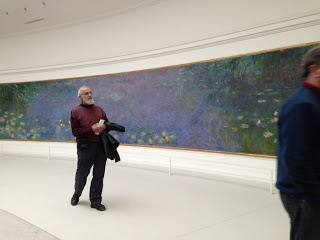
I would have taken more shots, but the guards were numerous and vigilant.
I walked and stared and studied these paintings. Where you see bright lights, the paint is thick, the artist working relentlessly to capture exactly the right light. I thought about the man doing the work. He started these eight pieces at age 81 and finished them about a year later. His eyesight was failing. Impressionism as a movement was history. With all of this against him, he created these amazing masterworks, canvases full of passion and light and the soul of Giverny, a place he loved.
I've thought a lot about my writing this trip, and myself as an artist, and a great deal of thinking has left me depressed about the tiny bit I've accomplished. Monet and the Nympheas, however, reminded me of a very simple truth: we have no excuse for not giving it our best. It doesn't matter how old you are, or what you've done before: you have to do the best work you can now. I have to do the best work I can now.
Thank you, Claude Monet, for the beautiful art and the inspiration.
The Orangerie also contains the many paintings that were the collection of Paul Guillaume. I particularly enjoyed his large set of Renoir canvases, many of which I had never seen before. I managed to sneak a shot of this one, which I loved.
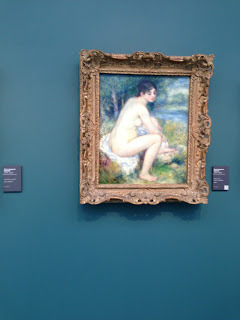
The third exhibit on display was a large selection of paintings by a group of Italian artists known as the Macchiaioli. The term began with critics, who used it to denounce their work as unfinished sketches, but the artists appropriated it for themselves. They worked in the second half of the 1800s and departed from the norms of their time by painting outdoors a great deal. I had known nothing about them before, but I very much enjoyed their work. I'll be on the lookout for more paintings from such artists as Giovanni Fattori and Giuseppe Abbati.
Outside, a few clouds were gathering, but the day was still gorgeous. Cleopatra's Needle gleamed in the daylight, but for some reason this shot made it look ominous against some dark clouds.
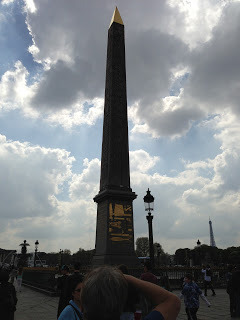
It was a perfect day for walking, so down the gardens I went. This statue, The Muse by A. Burganov, caught my fancy.
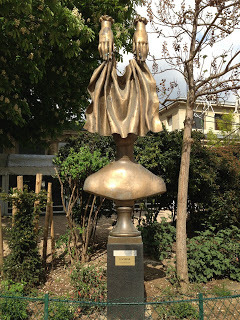
The gardens screamed spring and were stunning.
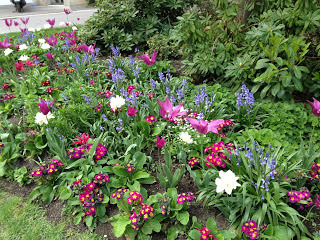
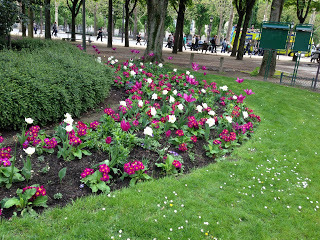
Near the end of the gardens, children sat on the grass and watched a Punch and Judy show in this nearly hidden little theater.
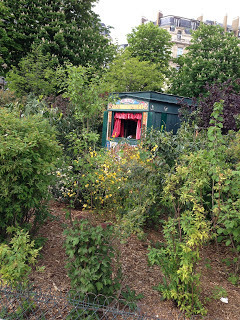
To top off the day, dinner was a return to Restaurant Guy Savoy for a truly remarkable meal that featured numerous delicious courses and service so good that other restaurants would be wise to hire the staff as trainers.
I could not have asked for a more perfect day in Paris.
Published on May 02, 2013 20:59
May 1, 2013
Holiday, rainy day, Eiffel Tower, Mom
May 1 is a national holiday in France, so all the museums, all the shops, and nearly all restaurants were closed today. It rained most of the day and was windy and brisk (mid fifties) outside. I am coming down with a cold. To top it off, today is Mom's birthday.
So, I didn't do much today.
I mostly slept, read, and relaxed. I went for a walk for some reasonably priced water and Coke Zero, and also because I'm now so in the habit of walking a lot every day that I don't feel right if I don't.
In the late afternoon, the rain stopped, but the day was still dreary and overcast. I'd been hoping to make it to the Eiffel Tower, and I figured a lot of people would have stayed away because of the weather. So, I grabbed a cab there--the couple of mile walk would have been too much in this weather given my cold--and was able to get upstairs easily and relatively quickly.
Even through the haze, the view was gorgeous.
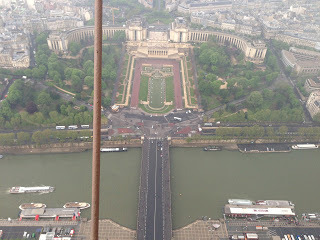 Click on any image to see a larger version.
Click on any image to see a larger version.Paris can't help but be lovely.
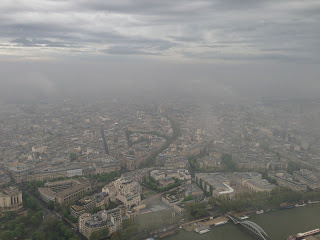
A view of the tower from a nearby pond and grotto that I hadn't visited before.
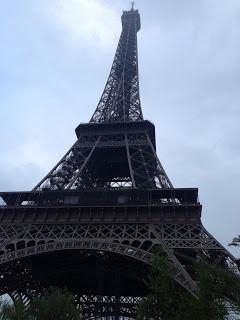
Said pond and grotto, which I quite liked.
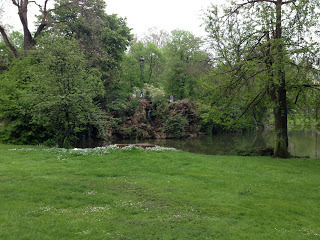
I'm mostly losing to this cold, so I've decided to take a nighttime cold medicine in the hopes that it will dry up my sinuses and help me avoid getting sicker. Given all the places I've been and all the crowds I've encountered, I suppose getting a cold was likely, if not inevitable. Still, I hope to stop it before it becomes bad.
Mom's birthday makes this a bit of a melancholy day, because I miss her very much. I think of her and miss her often. I suppose I always will.
Tomorrow, cold permitting, I hope to go see more great art!
Published on May 01, 2013 20:59
April 30, 2013
Versailles fail
During this trip, I've made it a point to see as many grand palaces and collections as possible. Being in Paris, I thus clearly had to go see the Palace of Versailles, where Louis XIV showed that he could live in as much luxury as anybody.
The train ride there was quick (35 minutes), easy, and mostly pleasant. The only unpleasant bit occurred when a pair of older men with accordions insisted on playing two songs and then demanded that all of us in the car pay them to make them stop. (Okay, maybe that's not what they intended, but that's how it felt.) You can just see the keyboard of one of them in this blurry photo.
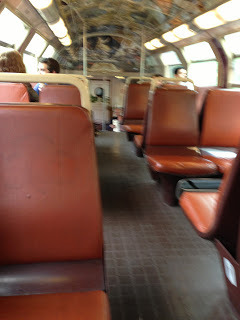 Click on any image to see a larger version.
Click on any image to see a larger version.From the train station, it's a short walk to the avenue that leads to the grand palace. Along the way, you encounter this statue of the Sun King; I liked that a bird was resting comfortably atop him.
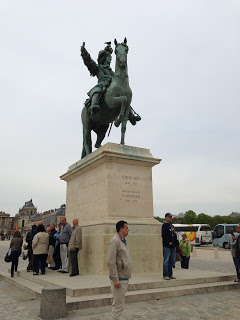
The approach was lovely, but the palace was thronged with tourists, more than I've encountered at any other place.
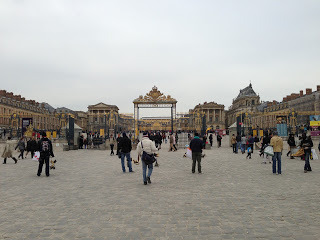
Everywhere else I've gone on this trip, I've waltzed up, stood in a short line for tickets, stood in another line to enter, and been inside the place in a very short time.
Not here. After over two hours standing in the line for people who needed to buy tickets, a woman announced in several languages over loudspeakers that the line to get in was at least an hour and a half long. I still didn't have a ticket, though I could see the door to the ticket area, so a little quick arithmetic made clear that I'd be lucky to get an hour in the place. Though I hated wasting all that time freezing--it was 54, but the wind was constant and routinely gusted to 18 mph--there was no point in continuing.
Later, I asked the concierge about Versailles, and he had a drawer full of tickets he sold for the same price as the ticket shop at the palace.
My Versailles fail was not a pretty thing. I was stupid, and I paid for it.
Back near the train station in Versailles, I veered into a warm and cozy cafe for a very late lunch of wonderful Vittel water
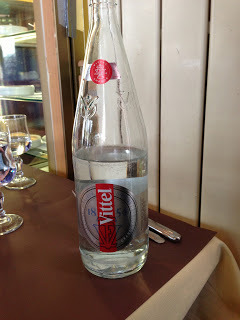
and a very tasty Croque Madame sandwich with salad.
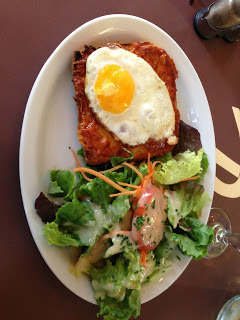
Back in Paris, the trees in the Tuileries were green and lovely, so I stopped nearly in the middle of the main path for a shot toward the Arc de Triomphe
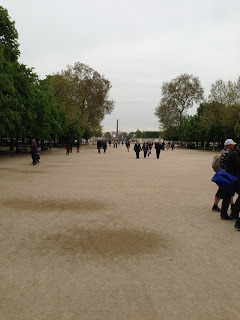
and another in the opposite direction toward the Louvre.
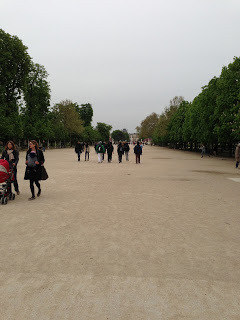
It's easy to forget how long the Tuileries is.
The carousel was operating, and kids were happily riding it.
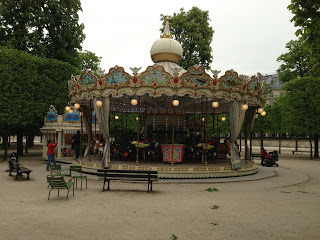
The chestnut trees were blooming in vivid white and pink.

A 1908 statue of Charles Perrault by Gabriel Edouard Baptiste stood near where a group of kids were playing on an awesome multi-trampoline construction that I wished I could have played on, too.
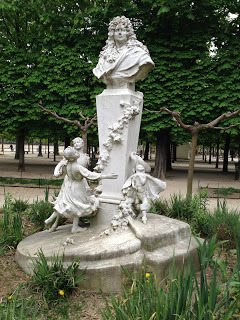
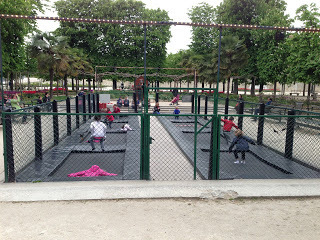
A little further along, this lovely 1695 Pierre Legros statue, Veturie ou le Silence ou Vestale, stood in the same gardens where it has been since 1722, longer than the U.S. has been an independent nation.

Nearby, a far more modern fountain attracted few admirers on this blustery day.

I expect that on warm days it would be a huge draw.
Perhaps I will take another run at Versailles later this week. Or not. Stay tuned to find out.
Published on April 30, 2013 20:59
April 29, 2013
Travelin' Man, once again
As I mentioned in
I figured to grab lunch there and ultimately did (pizza), but along the way I rejected many of the foods on offer. This one gathered my quickest rejection.
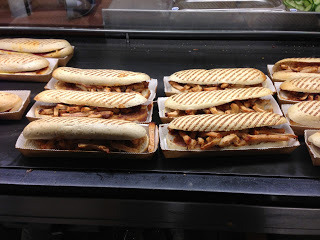 Click on any image to see a larger version.
Click on any image to see a larger version.Yup, it's a French Fry sandwich. No, there's no meat in it; just fries.
A first-class seat in a high-speed European train is a fine way to travel. It included free Wi-Fi and even a snack, with the world's tiniest can of Diet Coke (but no Coke Zero, alas).
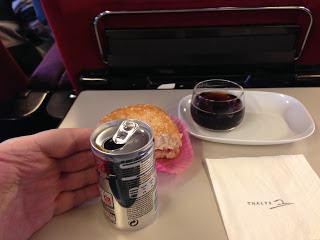
My hand is in the picture to illustrate the height of the can.
The scenery during the ride was frequently beautiful and full of green fields no doubt ready for planting (or already planted).
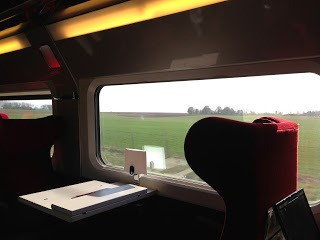
By the time I'd settled into the hotel, it was fairly late, so dinner was at the hotel restaurant. I took a brisk walk afterward in search of Coke Zero, but to no avail. Still the scenery not far from the hotel was lovely.
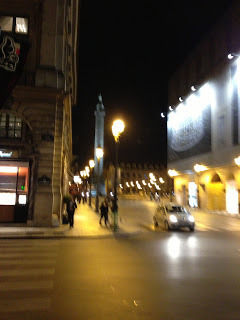
I won't play games with you this time: I'm back in Paris, where I'll stay, except perhaps for a side trip, until I fly home Saturday. Still so much to do and see!
Published on April 29, 2013 20:59
April 28, 2013
The Stedelijk Museum and modern art
The concierge had suggested that I wait on the Rijksmuseum until tomorrow, to avoid the weekend traffic, so I took his advice and instead headed to the Stedelijk Museum to check out some modern art. A great deal of modern art leaves me cold, but I am trying art of all sorts this trip, so the visit seemed like a good idea.
Along the way, a Tesla roadster mocked me from a side street.
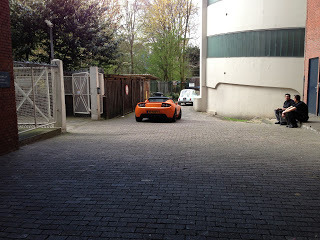 Click on any image to see a larger version.
Click on any image to see a larger version.Fortunately, I have zero interest in owning an orange car.
Closer to the museum, a small band played alongside a fake cow atop a houseboat whose roof was ringed with planters.
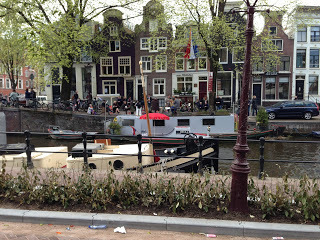
For no good reason, I love stuff like this.
Across the street from one side of the Rijksumuseum, which is just before the Stedelijk, stood several lovely Victorian houses, including this one, which I particularly liked.
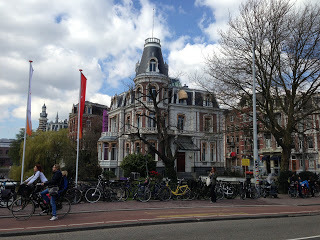
A gate that will ultimately be one of the entrances to the Rijksmuseum appealed to me for no particular reason.
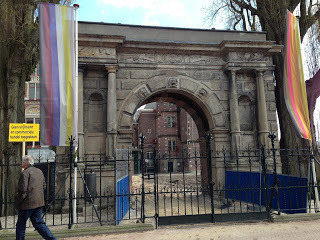
Passing a refreshment stand in an open area between the two museums, I learned that my instinct was correct: Amsterdam is indeed ready for the motorized Hot Dog Throne of Doom. How else could one explain this guy?
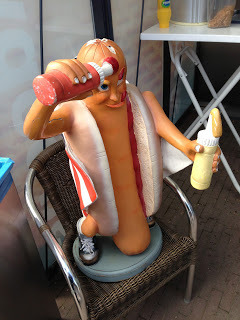
The facade of the Stedelijk is grafted onto an older brick building, making the combination kind of odd and kind of cool.

Inside, the collection began with a smattering of Impressionist pieces, which I predictably liked quite a bit, and then moved forward in time. I was happy to have been able to study this Cezanne, one of his over forty paintings of Mount Saint-Victoire,
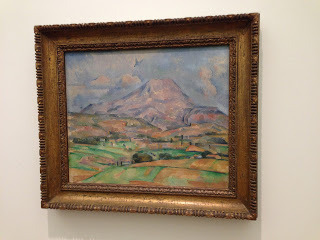
and this Monet, The House Among the Roses.
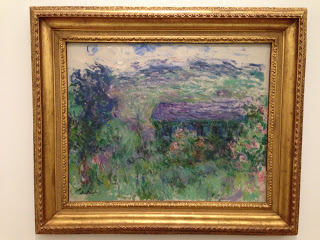
I also liked Van Gogh's Two Peasant's Digging
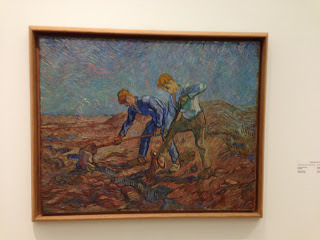
but I loved his Kitchen Gardens on Montmarte.
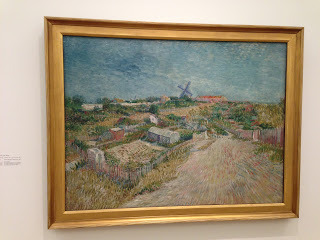
To my embarrassment, I knew next to nothing about Jan Sluijters (often "Sluyters" in English), and I still don't know much. Though most of the few bits I've now read about him call him a post-Impressionist, this piece, Bal Tabarin, which I loved, feels very much in the Impressionist tradition.

It's very large, and most of its space goes to the electric lights under which Parisians are dancing in a Montmarte ballroom. What you can't tell from the photograph is the sheer amount of paint Sluijters put on the canvas in his attempt to capture the electric lights perfectly. Viewed from the side the piece is almost lumpy with paint, the mounded result of an artist's struggle with his material.
All of these pieces, as well as several others, hung in one large room. From that room onward, the collection, to my taste, went downhill.
I did enjoy some of it, such as this Chagall, The Fiddler.
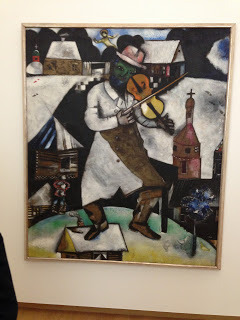
For no particular reason, I've always found Chagall's work at least interesting.
Mondrian's work has, for the most part, left me cold. His structural obsessions are interesting, but they do not engage me. This piece, Tableau III: Composition in Oval, is one of his earlier works and interested me more than most of the others on display.
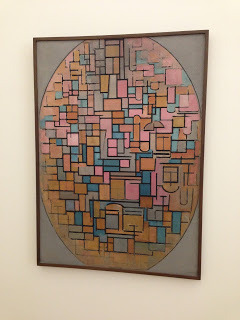
That said, I'd take any of the earlier pieces over this one any day.
Another artist with whom I was unfamiliar is Carel Willink, a Dutch painter in the Magic Realism school. I very much liked this piece of his.
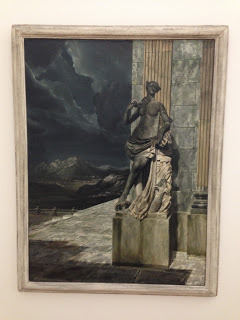
I appreciated the several Picasso paintings on display, but none spoke to my heart. Nor did the Braque, nor the one Diego Rivera, a somewhat abstract piece.
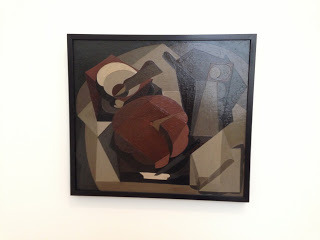
(I generally quite like Rivera's work.)
My ignorance of art knows no bounds, so I wasn't surprised to see another odd painting, How-Ever, that interested me by another artist whose work I did not know, Roberto Matta.
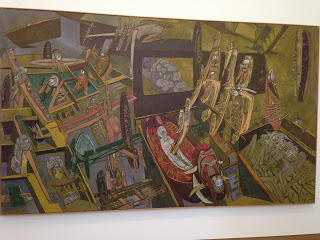
This Chilean artist, the museum's write-up explained, was a major figure in Surrealism. As I said, there are no bounds on my ignorance of art.
I didn't take many more photos after this point, because the work stopped speaking to me.
On the walk back, a shop claimed to offer authentic Italian gelato. I, of course, had to test this claim. Though not up to the best of Grom, it was tasty.
This car is but one of many oddities appearing all around the city as we draw closer to the coronation.
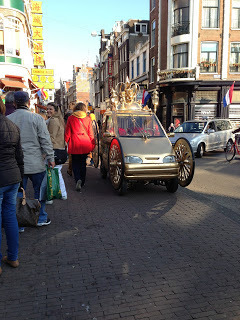
Back at the hotel, I went to the Rijksmuseum's site and learned that the advice of the concierge, who had been great in all other areas, was terribly wrong: the museum is closed tomorrow. Add to that disappointment the fact that the city will be thronged with tourists on Queen's Day, and it was clear that I was not going to get to see the Rijksmuseum. Also clear was what I should do next: move on!
So, tomorrow, I depart Amsterdam.
Published on April 28, 2013 20:59
April 27, 2013
Ah, Peter
Today's main excursion was a visit to the Hermitage Museum in Amsterdam. As I mentioned in
Overall, the exhibit was a little bit disappointing, but possibly in large part because I had my mind set to view more great art. Still, I enjoyed it and learned quite a few interesting things about a man I had studied when I was a child. (St. Petersburg, Florida, where I grew up, is the sister city of Peter the Great's St. Petersburg, so the interest was a natural one.)
For example, Peter created a club, The All-Joking, All-Drunken Synod, and he issued a decree with rules for it.
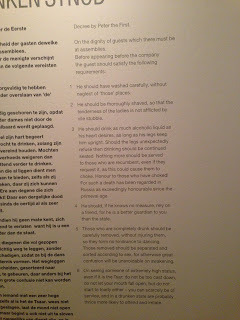 Click on any image to see a larger version.
Click on any image to see a larger version.When Peter partied, he partied hard.
I also had never internalized how tall he was: nearly six feet seven inches tall. Seeing a cloak made to his size was illuminating.
Peter was deeply into medicine of all sorts. He traveled with an extensive medicine cabinet.
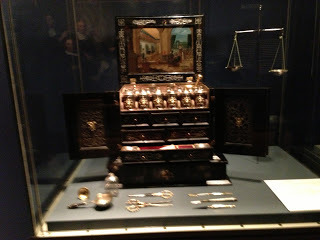
And his own portable latrine, for apparently he suffered from frequent intestinal distress (and hemmorhoids).
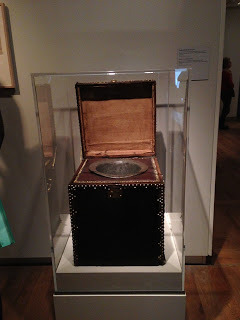
Peter kept with him a large set of personal medical instruments, some of which, along with a very cool medical pop-up book, you can see here.
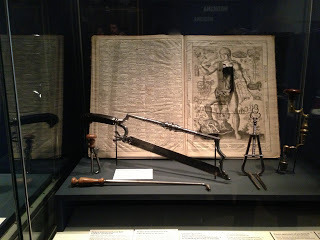
In the left rear are a tooth extractor and a bone saw. Front left is a cauterizer. To the right are the duck-billed anal speculum and a trepanning drill. If you complained of ailments and Peter heard you, he was apt to come after you and insist on treating you himself. As the exhibit noted, people in his circle were particularly afraid of his tooth pliers and would never complain of a toothache.
Who could blame them?
Over time, Peter assembled, in large part with the help of agents out shopping for him but also from gifts from friends, his own kunstkammer. It included these medical exhibits: the wet-preserved partial arm and partial head of a child, and the dry-preserved foot of a child.
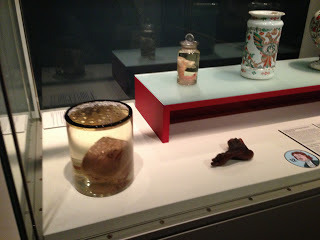
Peter's interests were vast and varied.
He loved to work at lathes, such as this beauty of his.
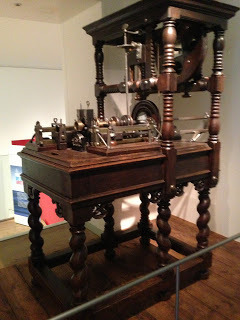
Friedrich-Christian Weber, an envoy from Hanover in St. Petersburg, wrote,
"Usually he is in the Secret Council from three to four in the morning. Then he visits the shipyard, directs the works and contributes in person, for he knows the profession, from the tiniest details to the grandest line. Around nine or ten o'clock he relaxes by working on a lathe, where he makes the most magnificent things."Among the art in his collection were many pieces from the Orient. I particularly liked this one, which an artist carved from the roots of a tree to tell the stories of the eight immortal figures of Buddhism.
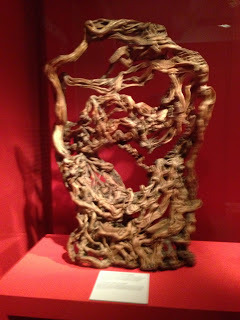
The gem of the collection, though, was this Rembrandt, David's Farewell to Jonathan, which was absolutely stunning in person.
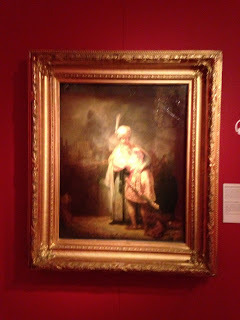
Out on the street, a sofa had appeared next to the canal, and a party was growing around it. (Sorry about the finger in the shot.)
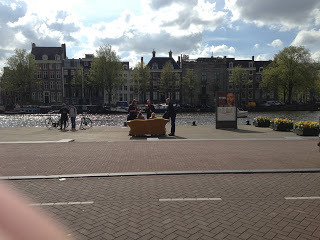
A drawbridge!
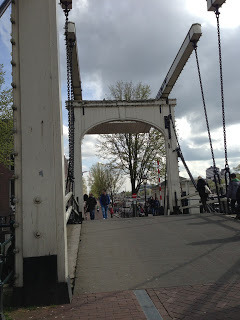
A chance encounter with a small garden behind a locked fence.
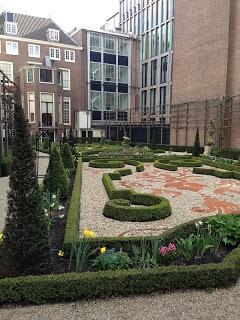
The cast of Rembrandt's Night Watch as statues standing in front of a statue of the man himself in the square that bears his name.

Wandering is wonderful fun here.
Published on April 27, 2013 20:59



